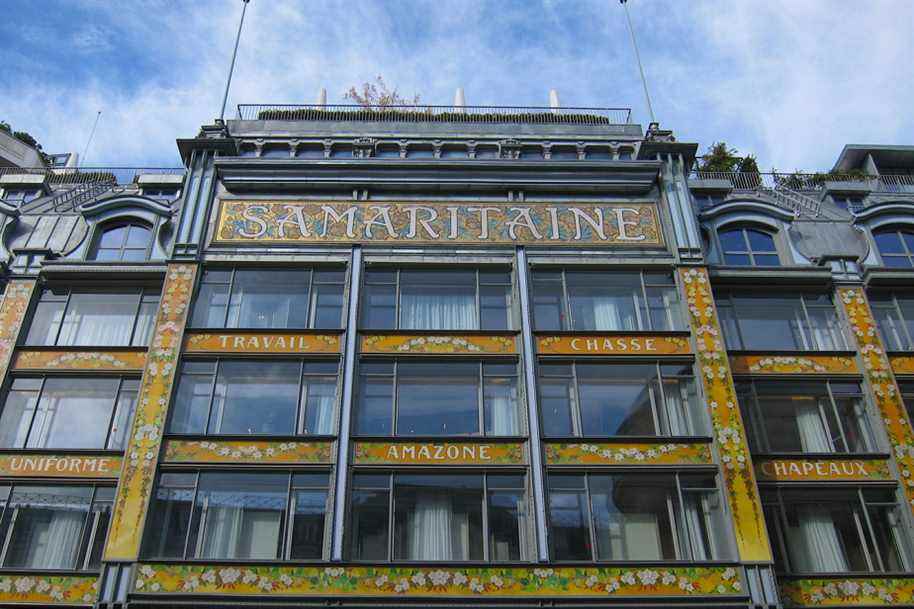(Paris, France) The iconic Parisian department store La Samaritaine, a true jewel of Art Deco and Art Nouveau, has regained its former glory after a closure that lasted 16 years.
Located a stone’s throw from the Pont-Neuf, the store founded in 1870 by Ernest Cognacq is once again attracting fashion aficionados and the curious alike. It must be said that the place has something to open your eyes wide.
Its exterior is an amalgamation of styles which testify to the mastery of the architects of the time.
The facade overlooking the Seine, erected between 1926 and 1928, is made of freestone, glass and steel. A typical Art Deco decor.
On the flanks, the building is in the purest Art Nouveau style, with its enamelled lava plates in bright colors. In 1930, this open-air work of art was covered with whitewash. The recent revamping of the place has made it possible to rediscover this magical setting (even if certain architectural elements have disappeared forever, such as the Art Nouveau canopies of the side entrance).

PHOTO STÉPHANIE MORIN, THE PRESS
The facade of the store, rue de Rivoli, displays a resolutely modern air.
Finally, the facade that overlooks rue de Rivoli has a resolutely modern look thanks to the good care of Japanese architects Kazuyo Sejima and Ryue Nishizawa, who have endowed the exterior wall with a coating of corrugated glass in which the surrounding buildings are reflected.
Surprise inside
The interior is even more surprising, with several stunning decor elements. The grand staircase is undoubtedly one of the lot, with its ornate balustrades, decorated with chestnut leaves with a copper patina. The staircase has been completely renovated, which made it possible to remove the linoleum which – sacrilege! – covered the steps with raw oak.
-

PHOTO STÉPHANIE MORIN, THE PRESS
The peacock fresco can be admired on the top floor of La Samaritaine.
-

PHOTO STÉPHANIE MORIN, THE PRESS
The grand staircase is undoubtedly one of the most spectacular elements of the architecture of La Samaritaine.
-

PHOTO STÉPHANIE MORIN, THE PRESS
Aerial view of the ground floor (and marble floors) of La Samaritaine
1/ 3
On the upper floor, under the glass roof which gently lets light filter in, you can admire the peacock fresco, which in itself is worth a visit. It was also covered with whitewash in the 1930s – which gave the place a cold atmosphere of an airport hall… – the fresco has been restored, in particular from period photographs.
To treat yourself to a little moment of rest in this setting of great beauty, you can sit down at the restaurant or bar located at the top of the stairs to taste – ultimate luxury – a glass of champagne. Or a coffee with a dessert …
With its area of 3400 m2 which has made La Samaritaine the largest department store in Europe (since England left the European Union), there is no shortage of food options. Caviar bar, fine bakery, pastry with macaroons of all colors …
On the shopping side, as they say in Paris, all the major brands of clothing for men and women are present. An entire floor is devoted to shoes. Another in jewelry.

PHOTO STÉPHANIE MORIN, THE PRESS
Here, clothes and accessories are exhibited like so many works of art.
Our favorite ? The basement, with its rows of perfumes, creams and beauty treatments. The store also has a spa; we didn’t dare look at the price card …

PHOTO STÉPHANIE MORIN, THE PRESS
An armchair invites customers to sit down between two purchases.
In fact, La Samaritaine is so vast that it offers guided tours of one hour and a half for the price of 15 euros. Interesting for those who wish to obtain more historical information (on the founder in particular), but disappointing for those who believed, like the author of these lines, to have access to places closed to the general public. Like the famous terrace that tops the building. In the past, visitors used to come for tea while admiring the rooftops of Paris and the Seine. Today, the terrace is for the exclusive use of guests of the Cheval Blanc hotel-palace, which now occupies the building facing the Seine. Pity…

